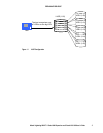PRELIMINARY RELEASE
Hitachi Lightning 9900™ V Series LUN Expansion and Virtual LVI/LUN User’s Guide 5
Note: Virtual LVI/LUN used in conjunction with FlashAccess can achieve greater performance
improvements than when either of these options is used individually. For more information
on FlashAccess, see Hitachi Freedom Storage™ Lightning 9900™ V Series FlashAccess User’s
Guide (MK-92RD102).
A parity group is called a normal or fixed-size volume (FV) when all of its member LDEVs are
fixed-size. In a normal volume, the size of the member LDEVs is determined by type of
device that is being emulated, and the number of LDEVs is determined by the physical size
of the parity group.
Generally, each array group will have a certain amount of free space available after the
standard LDEVs for the array group have been defined. On the 9900V, Virtual LVI/LUN
formats one or more of the LDEVs on a selected volume into free space. That free space can
either be used to install one or more variable-sized volumes, or left as free space for future
use. Note: At least one LDEV must remain defined as a normal volume in each array group.
The following parameters apply to Virtual LVI/LUN operations:
S/390
®
volumes must be offline from the host OS, and open volumes must be either
offline or unmounted from the host OS with no SCSI paths assigned to them. For more
information on configuring SCSI paths, please see Hitachi Freedom Storage™ Lightning
9900
TM
V Series LUN Manager/SANtinel User’s Guide (MK-92RD104).
Multiple LDEVs can be selected for conversion to Virtual LVI/LUN volumes but they must
be in the same parity group.
When space in an LDEV is converted to a Virtual LVI/LUN volume, an LDEV address is
assigned to that Virtual LVI/LUN volume automatically. For mainframes, each Virtual
LVI/LUN volume will also have its own assigned unit control block (UCB). The UCB can be
assigned either automatically or manually, at the user’s option.
LUSE, volumes secured by LUN Security, and Hitachi SANtinel – S/390
®
volumes are not
available for Virtual LVI/LUN operations, because these volumes must have SCSI paths
already defined. To create a VLL/LUSE volume, you must first create two or more Virtual
LVI/LUN volumes with the same size, emulation type and CU number, and then combine
those volumes into a LUSE device. For more information on creating LUSE devices see
Chapter 3.
Virtual LVI/LUN operations are not available for OPEN-L volumes.
When you convert a normal volume to a Virtual LVI/LUN volume, you can use all or part
of the space previously assigned to that volume (e.g., 3339 cylinders for a 3390-3) for
use in Virtual LVI/LUN volumes. Each array group can support a total of 256 volumes,
including both fixed-size and Virtual LVI/LUN volumes.
WARNING: The Virtual LVI/LUN function is destructive. Be sure to back up your data before
performing Virtual LVI/LUN operations.


















